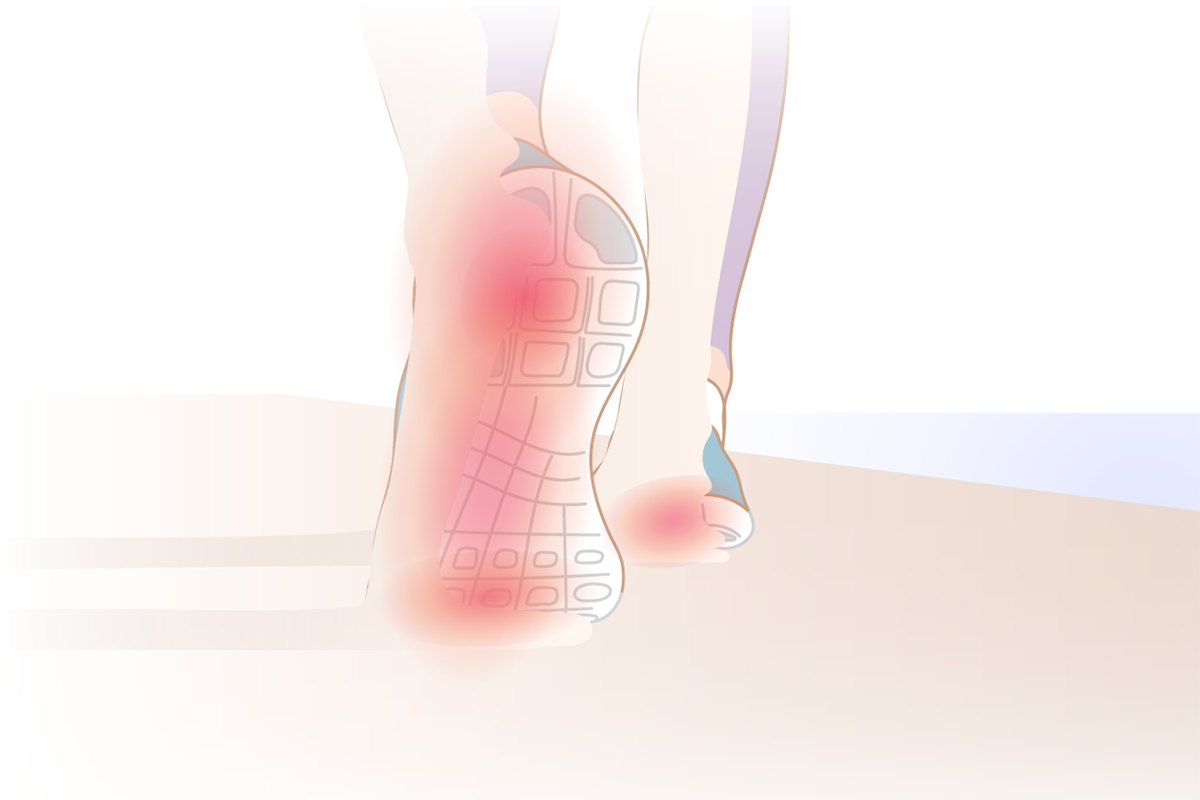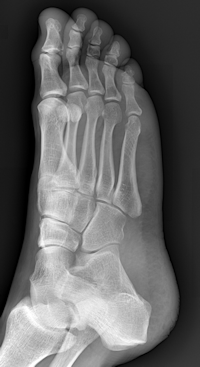
When your feet hurt, it can affect your entire day! If you're on your feet a lot -- whether by profession or recreation (or both!) -- your feet give you the foundation to conquer your day.
So many common foot issues can be solved with our custom fitting process.
Our certified pedorthists at Tops Shoes can fit you properly in the shoes or boots that will not only keep you comfortable but working your best, including proper size, width, custom orthotics, and more -- but also be durable and attractive. We work in conjunction with your medical professionals to find the best solutions, even if your feet are an uncommon size and width.
Read below for just a few of the common foot conditions often seen by our certified pedorthists. Remember, you should discuss any medical issue with your trusted physician; our services are not a replacement for medical care. If you wish to read more on any of the conditions mentioned below, links have been provided to original sources.
Call us today at 501-794-1501 to set up an appointment for a consultation. We make your feet comfortable! Find out what we can do for you.

What is a pedorthist?
"An ABC Certified Pedorthist (peh-DOR-thist) or C.Ped., is a health care professional specifically educated and trained to manage comprehensive pedorthic patient care. This includes patient assessment, formulation of a treatment plan, implementation of the treatment plan, follow-up and practice management. Pedorthic care includes patient evaluation, and the design, fabrication, fitting, modification, maintenance and repair of pedorthic devices for the prevention or amelioration of painful and/or disabling conditions that originate at the ankle or below."
See some of the common conditions, below, that can be improved by consulting with a certified pedorthist at Tops Shoes.
Arthritis
Arthritis is inflammation of one or more of your joints. It can cause pain and stiffness in any joint in the body and is common in the small joints of the foot and ankle.
There are more than 100 forms of arthritis, many of which affect the foot and ankle. All types can make it difficult to walk and perform activities you enjoy.
Although there is no cure for arthritis, there are many treatment options available to slow the progress of the disease and relieve symptoms. With proper treatment, many people with arthritis are able to manage their pain, remain active, and lead fulfilling lives.
Achilles Tendonitis
Achilles tendinitis is a common condition that occurs when the large tendon that runs down the back of the lower leg becomes irritated and inflamed.
The Achilles tendon is the largest tendon in the body. It connects the calf muscles to the heel bone and is used when you walk, run, climb stairs, jump, and stand on your tip toes. Although the Achilles tendon can withstand great stresses from running and jumping, it is also prone to tendinitis, a condition associated with overuse.
Bunions
A bunion is a bony bump that forms on the joint at the base of your big toe. It occurs when some of the bones in the front part of your foot move out of place. This causes the tip of your big toe to get pulled toward the smaller toes and forces the joint at the base of your big toe to stick out. The skin over the bunion might be red and sore.
Wearing tight, narrow shoes might cause bunions or make them worse. Bunions can also develop as a result of the shape of your foot, a foot deformity or a medical condition, such as arthritis.
Smaller bunions (bunionettes) can develop on the joint of your little toe.
Calluses
Corns and calluses are thick, hardened layers of skin that develop when your skin tries to protect itself against friction and pressure. They most often develop on the feet and toes or hands and fingers. Corns and calluses can be unsightly.
If you're healthy, you need treatment for corns and calluses only if they cause discomfort. For most people, simply eliminating the source of friction or pressure makes corns and calluses disappear.
If you have diabetes or another condition that causes poor blood flow to your feet, you're at greater risk of complications from corns and calluses. Seek your doctor's advice on proper care for corns and calluses if you have such a condition.
Diabetic Neuropathy
Diabetic neuropathy is a type of nerve damage that can occur if you have diabetes. High blood sugar (glucose) can injure nerves throughout your body. Diabetic neuropathy most often damages nerves in your legs and feet.
Plantar Fasciitis
Plantar fasciitis (PLAN-tur fas-e-I-tis) is one of the most common causes of heel pain. It involves inflammation of a thick band of tissue that runs across the bottom of each foot and connects the heel bone to the toes (plantar fascia).
Plantar fasciitis commonly causes stabbing pain that usually occurs with your first steps in the morning. As you get up and move, the pain normally decreases, but it might return after long periods of standing or when you stand up after sitting.
Morton’s Neuroma
Morton's neuroma is a painful condition that affects the ball of your foot, most commonly the area between your third and fourth toes. Morton's neuroma may feel as if you are standing on a pebble in your shoe or on a fold in your sock.
Morton's neuroma involves a thickening of the tissue around one of the nerves leading to your toes. This can cause a sharp, burning pain in the ball of your foot. You may have stinging, burning or numbness in the affected toes.
High-heeled or tight shoes have been linked to the development of Morton's neuroma. Many people experience relief by switching to lower heeled shoes with wider toe boxes.
Metatarsalgia
Metatarsalgia (met-uh-tahr-SAL-juh) is a condition in which the ball of your foot becomes painful and inflamed. You might develop it if you participate in activities that involve running and jumping. There are other causes as well, including foot deformities and shoes that are too tight or too loose.
Although generally not serious, metatarsalgia can sideline you. Fortunately, at-home treatments, such as ice and rest, often relieve symptoms. Wearing proper footwear with shock-absorbing insoles or arch supports might prevent or minimize future problems with metatarsalgia.
Shin Splints
The term "shin splints" refers to pain along the shin bone (tibia) — the large bone in the front of your lower leg. Shin splints are common in runners, dancers and military recruits.
Medically known as medial tibial stress syndrome, shin splints often occur in athletes who have recently intensified or changed their training routines. The increased activity overworks the muscles, tendons and bone tissue.
Most cases of shin splints can be treated with rest, ice and other self-care measures. Wearing proper footwear and modifying your exercise routine can help prevent shin splints from recurring.


